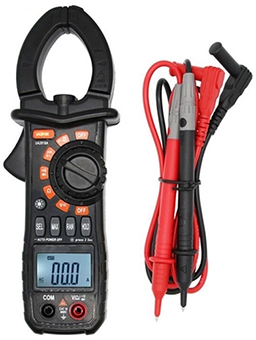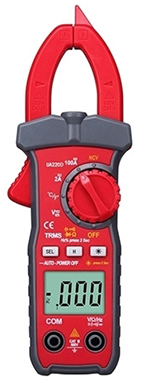How Does a Clamp Meter Work?
As one of the necessary test tools in daily maintenance work, the clamp meter is mainly used to test related parameters such as voltage, current, frequency, etc. It is required to have high test resolution, test accuracy and more test functions. Clamp meter is an instrument that integrates current and ammeter. It is an important branch of digital. Its working principle is the same as that for measuring current.
Clamp meter working principle
The clamp meter is composed of a current transformer and an ammeter. The iron core of the current transformer can be opened when the wrench is tightened. At this time, the wire through which the measured current passes can pass through the opening of the iron core without cutting it. When the wrench is released, the core closes. The circuit wire under test passing through the iron core becomes the primary coil of the current transformer, in which the current is induced in the secondary coil by passing the current. Thus, the ammeter connected to the secondary coil will indicate the current of the line under test. The clamp meter can be changed to different ranges through the shift of the switch. However, it is not allowed to operate with power on when shifting gears. The accuracy of the clamp meter is generally not high, usually 2.5 to 5 grades.
A clamp meter works like a transformer. The primary coil is the wire going through the pincer core, which is equivalent to the primary coil of a 1-turn transformer, which is a step-up transformer. The secondary coil and the ammeter for measurement constitute the secondary circuit. When an alternating current passes through the wire, this turn of the coil generates an alternating magnetic field, and an induced current is generated in the secondary loop. The ratio of the current to the primary current is equivalent to the inverse ratio of the turns of the primary and secondary coils. The clamp-type ammeter is used to measure large current. If the current is not large enough, the primary wire can be passed through the clamp-type meter to increase the number of turns, and at the same time, the measured current is divided by the number of turns.
The secondary winding of the through-core current transformer of the clamp-type ammeter is wound on the iron core and is connected with the AC ammeter. Its primary winding is the wire under test passing through the center of the transformer. The knob is actually a range selection switch, and the function of the wrench is to open and close the movable part of the iron core of the through-core transformer, so as to make it clamp the conductor under test.
Usually, when measuring current with an ordinary ammeter, it is necessary to cut off the circuit and stop it before connecting the ammeter for measurement. This is very troublesome, and sometimes a properly functioning motor doesn't allow it. At this point, it is much more convenient to use a clamp meter to measure the current without breaking the circuit.
How to use a clamp meter to measure current?
As a kind of instrument that can detect DC or AC power in the line under the power-on state, the clamp meter will be used in the layout or maintenance of the line in the process of our decoration. How to use such a commonly used tool in our life, and how does it repair the circuit?
When using the clamp meter, you should first carefully understand the operation manual and operation method of the clamp meter, the function of each button, and clearly grasp the important parameters such as the highest voltage or current tested by the clamp meter. Then carefully check whether the appearance of the clamp meter is damaged, as well as the cleanliness of the clamp meter, especially the placement of the insulating part and the test leads. Before each measurement, it is necessary to check whether the switch of the clamp meter is correct and whether the jack of the test lead is selected correctly.
After all inspections, it is necessary to make a rough estimate of the measured current under the condition of ensuring that the clamp meter is in good condition, and then select the gear of the clamp meter to be larger than the estimated value. When the clamp meter is first used, there may be instability in the number of hops. This requires waiting for a period of time, waiting for the display value to stabilize before reading.
When using the clamp meter, you should hold the insulating part of the clamp meter in your hand after adjusting the gear according to the different circuits under test, and press the switch with your thumb. Then, the jaws of the clamp meter will be opened, and carefully put the wire to be measured into the center of the iron core of the clamp meter, and then release the switch, and the iron core of the clamp meter will be automatically closed. Due to the current in the wire being measured, the alternating magnetic lines of force generated under the action of the iron core of the clamp meter, the clamp meter will measure the current value in the wire and display it on the clamp meter, until the value is in a stable state and read it directly. If there is noise when the wire is put into the center of the iron core of the clamp meter during the measurement, it should be taken out and placed again. If you put two wires at the same time, the accuracy of counting will be reduced.
After the measurement, it is necessary to adjust the current gear of the clamp meter to the highest level, so as to avoid forgetting the high level and damaging the clamp meter before the next use. Moreover, as a precision measuring instrument, the clamp meter should be removed from the battery after use, and stored in a safe and dry place, away from objects that can generate magnetic fields, so as to ensure the measurement accuracy of the clamp meter. If you do not know how to use the clamp meter, it is forbidden for one person to measure the current alone.

